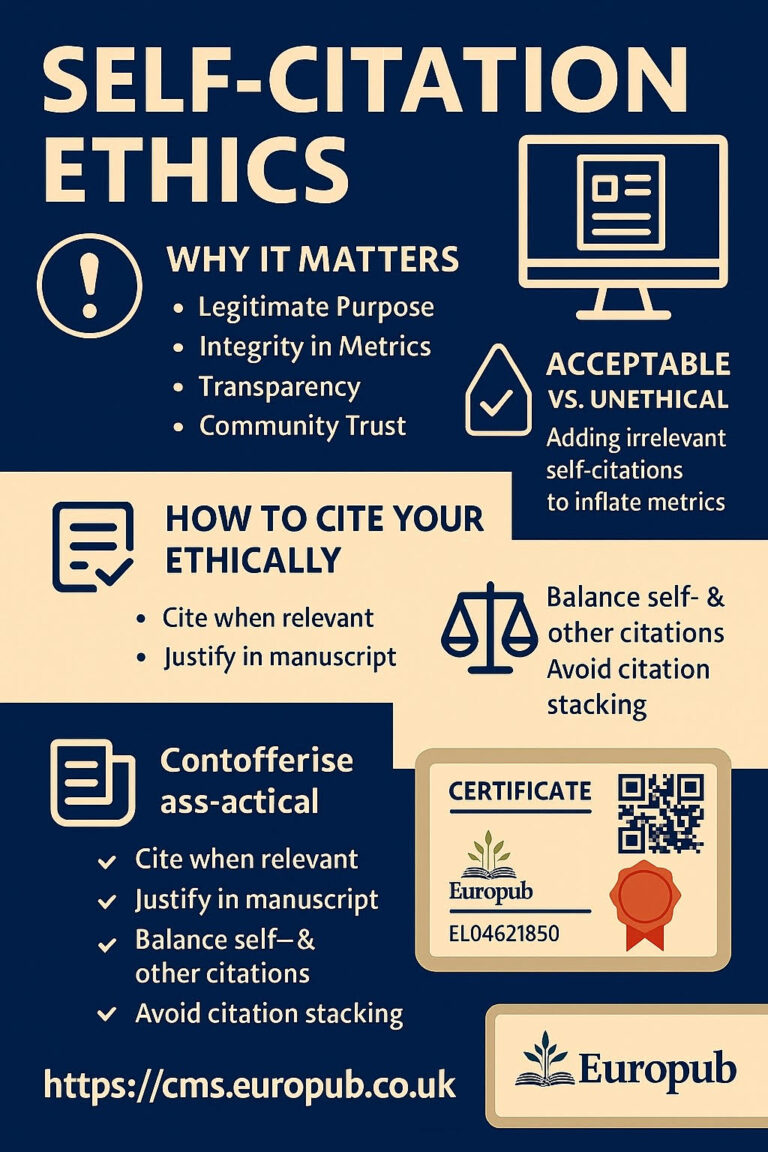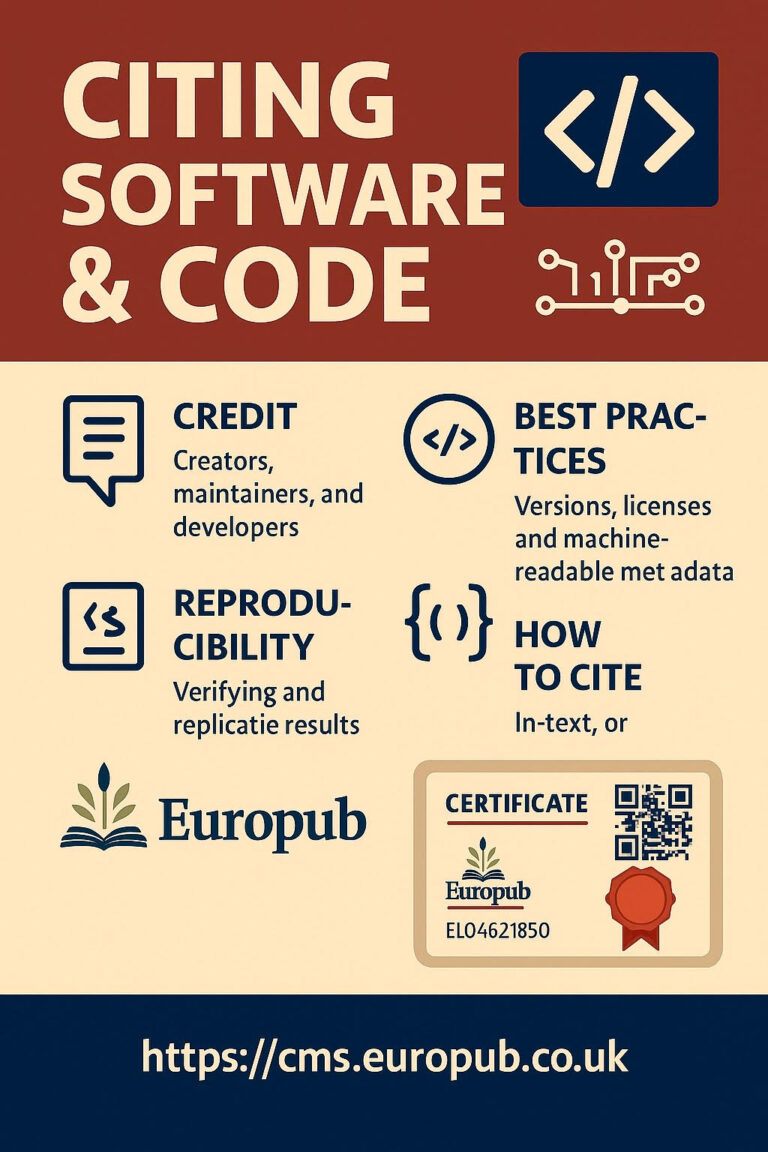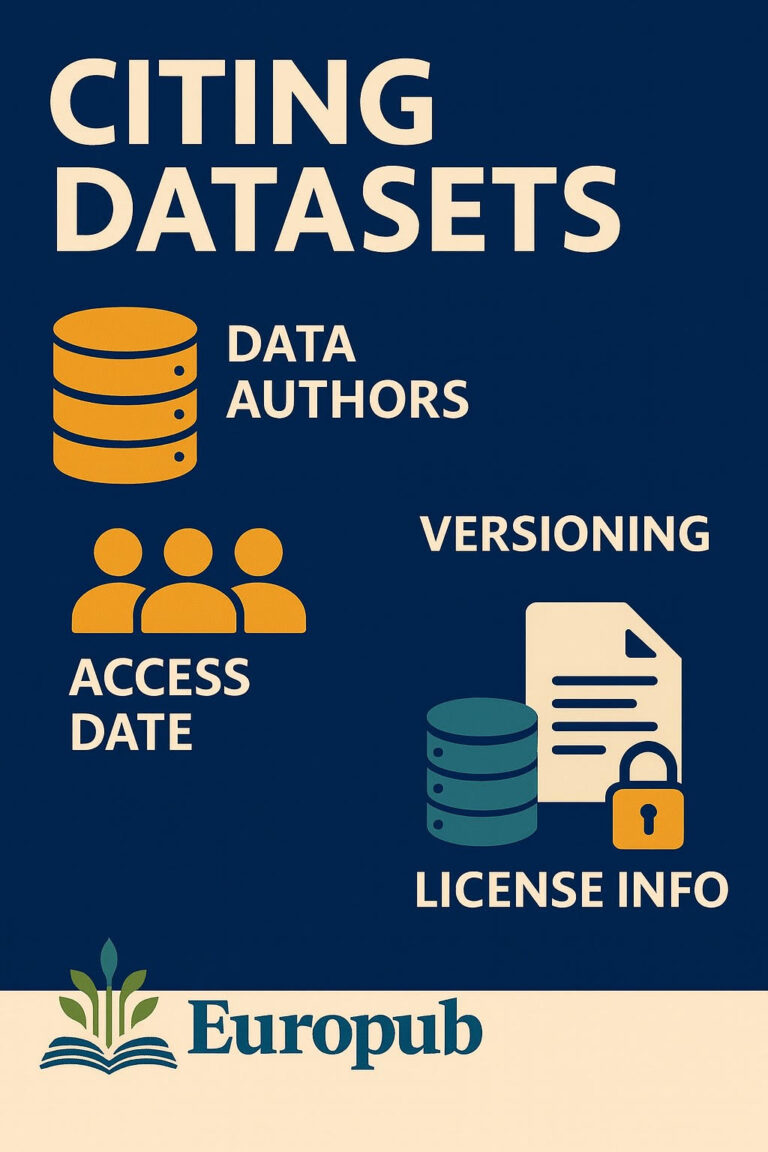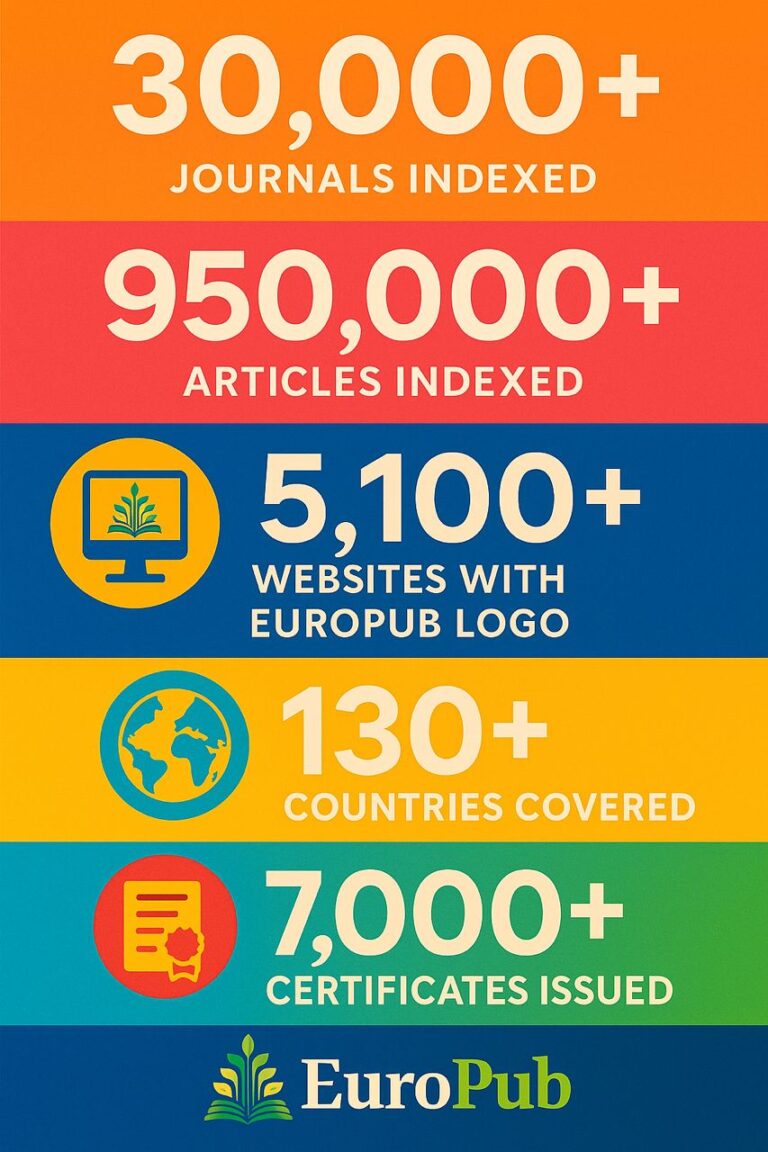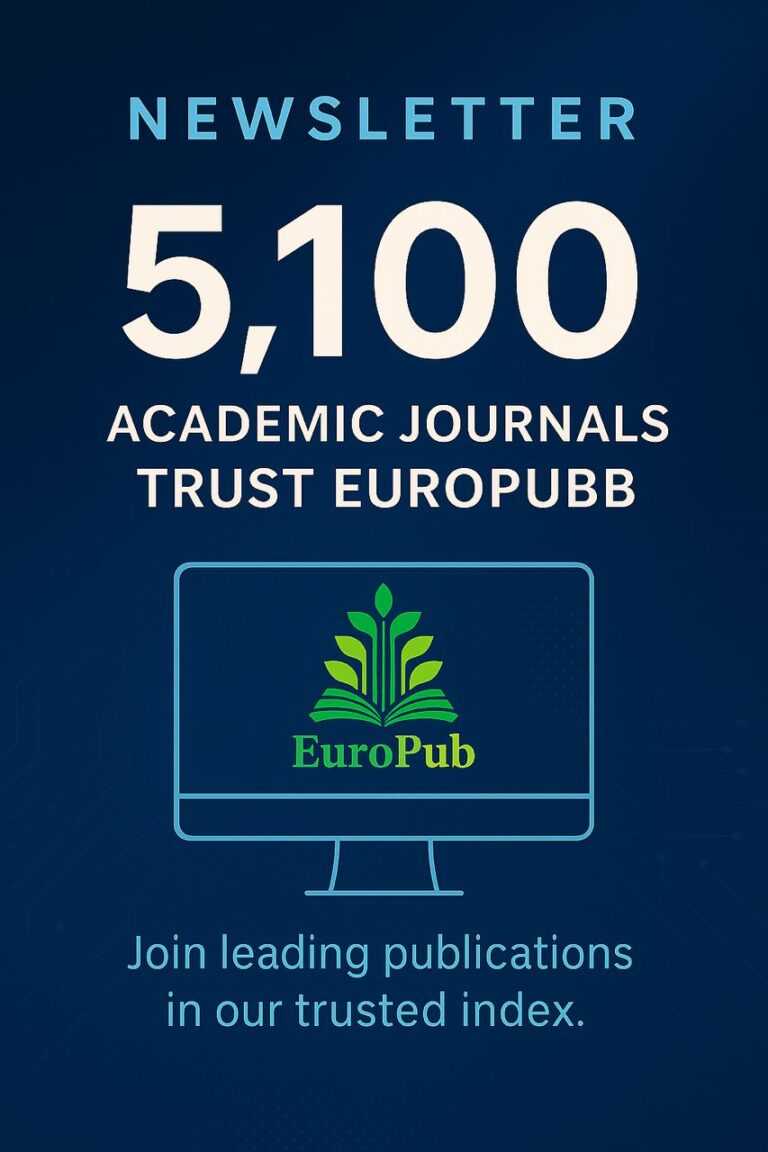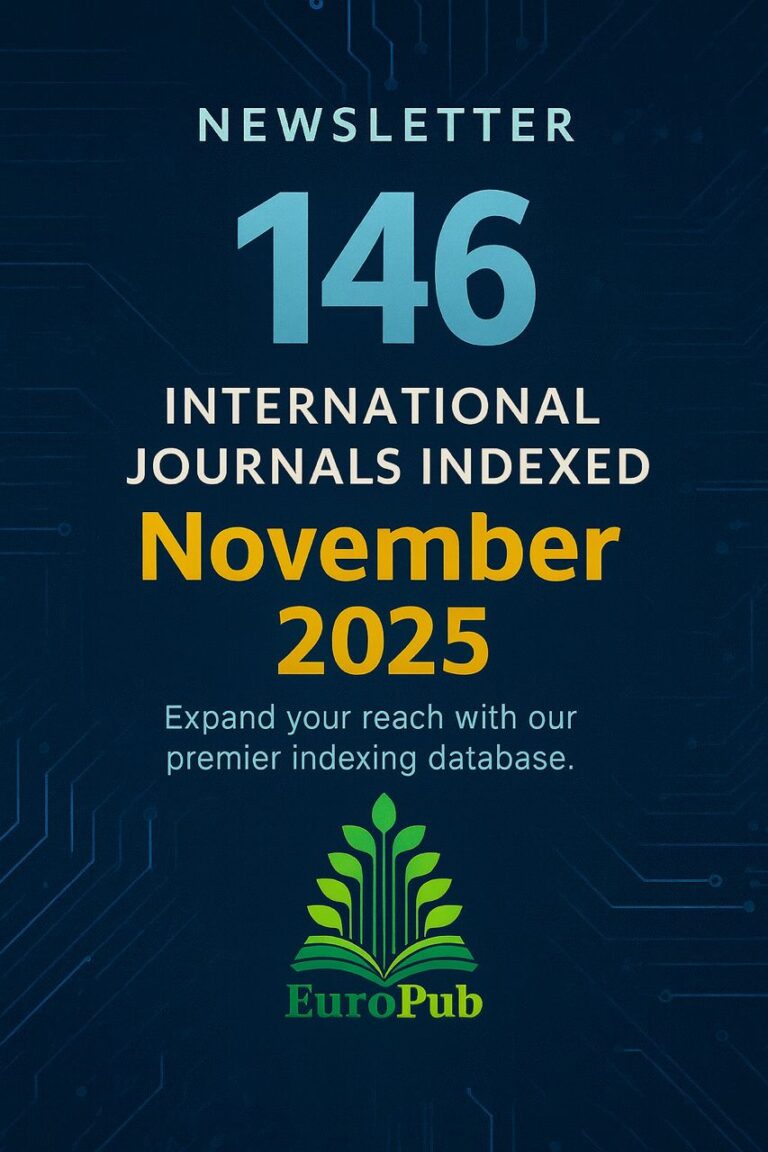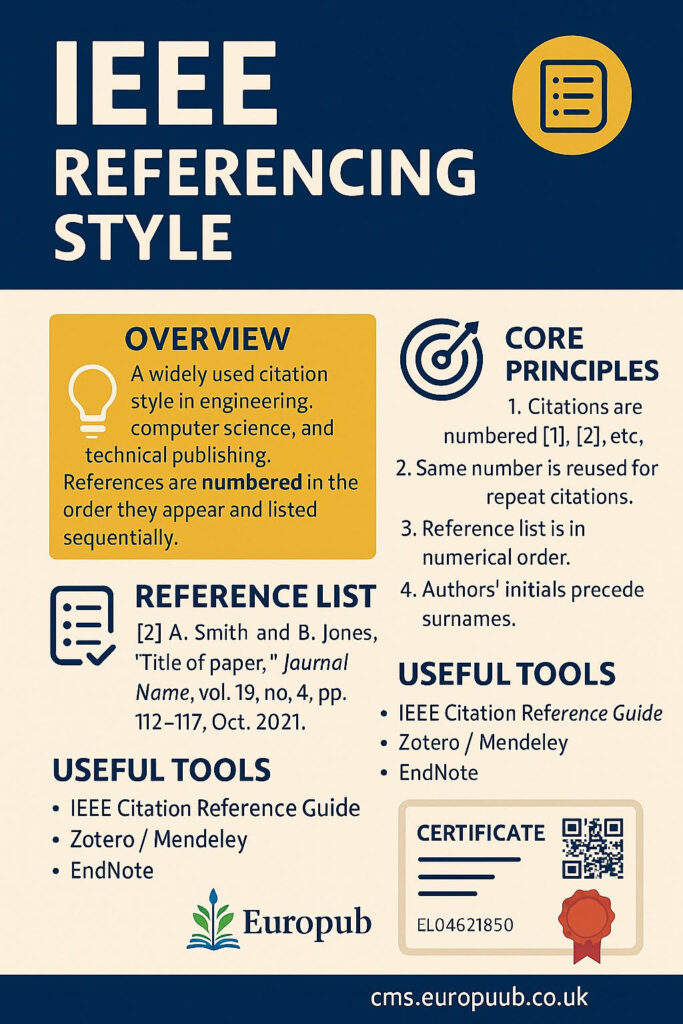
 Overview
Overview
The IEEE (Institute of Electrical and Electronics Engineers) referencing style is one of the most widely used systems in engineering, computer science, and technical publications.
It’s a numerical citation system — references are numbered in the order they appear in the text and listed at the end in the same sequence.
IEEE is known for clarity, consistency, and compactness, making it ideal for journals, conference papers, and reports in scientific and technological fields.
 Core Principles
Core Principles
- Citations are numbered in square brackets: [1], [2], [3].
- Numbers correspond to full references in the reference list.
- Each number is reused if the same source is cited again.
- References appear in numerical order, not alphabetically.
- Authors’ initials precede surnames.
 In-Text Citation Examples
In-Text Citation Examples
- As described in [1]…
- The results in [2], [3] confirm this theory.
- Several researchers [4]–[6] have demonstrated…
 Reference List Format
Reference List Format
General structure:
[Reference Number] Author’s Initial(s). Surname, “Title of paper,” *Journal Name*, vol. xx, no. xx, pp. xxx–xxx, Month, Year.
 Common Examples
Common Examples
1. Journal Article
[1] J. Smith and R. Brown, “Machine learning in renewable energy,” *IEEE Transactions on Energy Conversion*, vol. 36, no. 2, pp. 123–134, Mar. 2022.
2. Book
[2] D. K. Peterson, *Digital Signal Processing Fundamentals*, 3rd ed. New York, NY: Springer, 2020.
3. Conference Paper
[3] L. Wang, “AI-enhanced robotics,” in *Proc. IEEE Int. Conf. Robotics and Automation (ICRA)*, Paris, France, 2021, pp. 233–239.
4. Website
[4] IEEE, “Author digital tools,” https://www.ieee.org/publications/authors, accessed Sept. 10, 2024.
5. Thesis
[5] M. Ali, “Design of hybrid microgrids,” M.S. thesis, Dept. of Electrical Eng., Univ. of Manchester, U.K., 2021.
6. Online Report
[6] World Health Organization, “AI ethics in healthcare,” Geneva, 2023. [Online]. Available: https://www.who.int/ai-ethics
 Formatting Guidelines
Formatting Guidelines
- Font: Times New Roman, 10 or 12 pt
- Single spacing within citations
- Number references with square brackets (e.g., [1])
- Separate multiple citations by commas or hyphens
- Include all authors (up to 6); if more, use “et al.”
 Differences Between IEEE and Other Styles
Differences Between IEEE and Other Styles
| Feature | IEEE | APA | Harvard | Chicago |
|---|---|---|---|---|
| Citation Format | Numeric [1] | Author–Date | Author–Date | Author–Date / Footnote |
| Order in List | Sequential | Alphabetical | Alphabetical | Alphabetical |
| In-text Example | [4] | (Smith, 2023) | (Smith, 2023) | (Smith 2023, 15) |
| Field | Engineering, CS | Psychology | Social Sciences | Humanities |
 Useful Tools for IEEE Style
Useful Tools for IEEE Style
- IEEE Citation Reference Guide
- Zotero / Mendeley (IEEE style templates available)
- EndNote: “IEEE Transactions” output style
- Europub Certificate Platform: https://cms.europub.co.uk
 FAQ – IEEE Referencing (Extended)
FAQ – IEEE Referencing (Extended)
 General Understanding
General Understanding
Q1: What is the IEEE referencing system?
A: It’s a numerical citation system developed by the Institute of Electrical and Electronics Engineers for technical disciplines.
Q2: What fields use IEEE style?
A: Engineering, electronics, computer science, IT, and related research.
Q3: Is IEEE accepted globally?
A: Yes, it’s the default for IEEE journals, conferences, and many STEM publishers.
 In-Text Citations
In-Text Citations
Q4: How do I cite multiple sources together?
A: Use commas or hyphens, e.g., [1], [2], [5] or [3]–[6].
Q5: Can I cite the same source more than once?
A: Yes, reuse the same number assigned to that source.
Q6: Do citations go before or after punctuation?
A: Before punctuation (e.g., “as shown in [2].”).
Q7: How do I cite figures or tables?
A: “As illustrated in Fig. 2 [7]…”
 Reference List
Reference List
Q8: How should references be ordered?
A: By the sequence of appearance in the text.
Q9: Are URLs allowed in IEEE references?
A: Yes, include “Available:” followed by the full URL.
Q10: How do I handle long author lists?
A: List up to 6 authors, then use “et al.”
Q11: What if the publication has no date?
A: Use “n.d.” (no date).
Q12: Should the titles be capitalized?
A: Use sentence case for titles, title case for journals.
 Special Cases
Special Cases
Q13: How do I cite software or datasets?
A: [8] OpenAI, “ChatGPT Model 5.0 Dataset,” 2024. [Online]. Available: https://openai.com/models.
Q14: Can I cite personal communication?
A: Not preferred — use published or archived sources instead.
Q15: Can IEEE be used in non-engineering fields?
A: Yes, especially in data science, AI, and applied research.
Q16: How do I cite unpublished work?
A: Use “unpublished” after the title.
 Formatting & Structure
Formatting & Structure
Q17: What indentation is used?
A: No hanging indent — references are flush left.
Q18: What spacing is used?
A: Single spacing between lines, double spacing between entries.
Q19: How do I reference multiple papers from the same author?
A: Assign each a unique number in the order they appear.
Q20: Are DOIs mandatory?
A: Strongly recommended for digital sources.
 Publisher & System Integration
Publisher & System Integration
Q21: Does Europub accept IEEE format?
A: Yes, for engineering and technology-related journals.
Q22: How can I check my references automatically?
A: Use the Europub Certificate Management System: https://cms.europub.co.uk
Q23: Can Europub generate IEEE-compliant reference certificates?
A: Yes, available for editors and authors after validation.
Q24: Does IEEE style work with Scopus and Web of Science indexing?
A: Yes, it aligns with global metadata standards.
Q25: What’s the citation style in IEEE conference papers?
A: The same IEEE numeric format applies.
 Practical Author Tips
Practical Author Tips
Q26: Always cross-check against IEEE Reference Guide PDF.
Q27: Verify conference names (don’t abbreviate arbitrarily).
Q28: Use proper capitalization for organization names.
Q29: Include all access dates for online sources.
Q30: Always double-check author initials and publication years.
 Summary
Summary
IEEE referencing ensures:
- Precision
- Global recognition
- Compatibility with major indexing databases
- Easy integration with Europub certificate and impact evaluation systems
 Prepared by: Europub Publishing Company Ltd. UK
Prepared by: Europub Publishing Company Ltd. UK
 Certificate Management: https://cms.europub.co.uk
Certificate Management: https://cms.europub.co.uk
